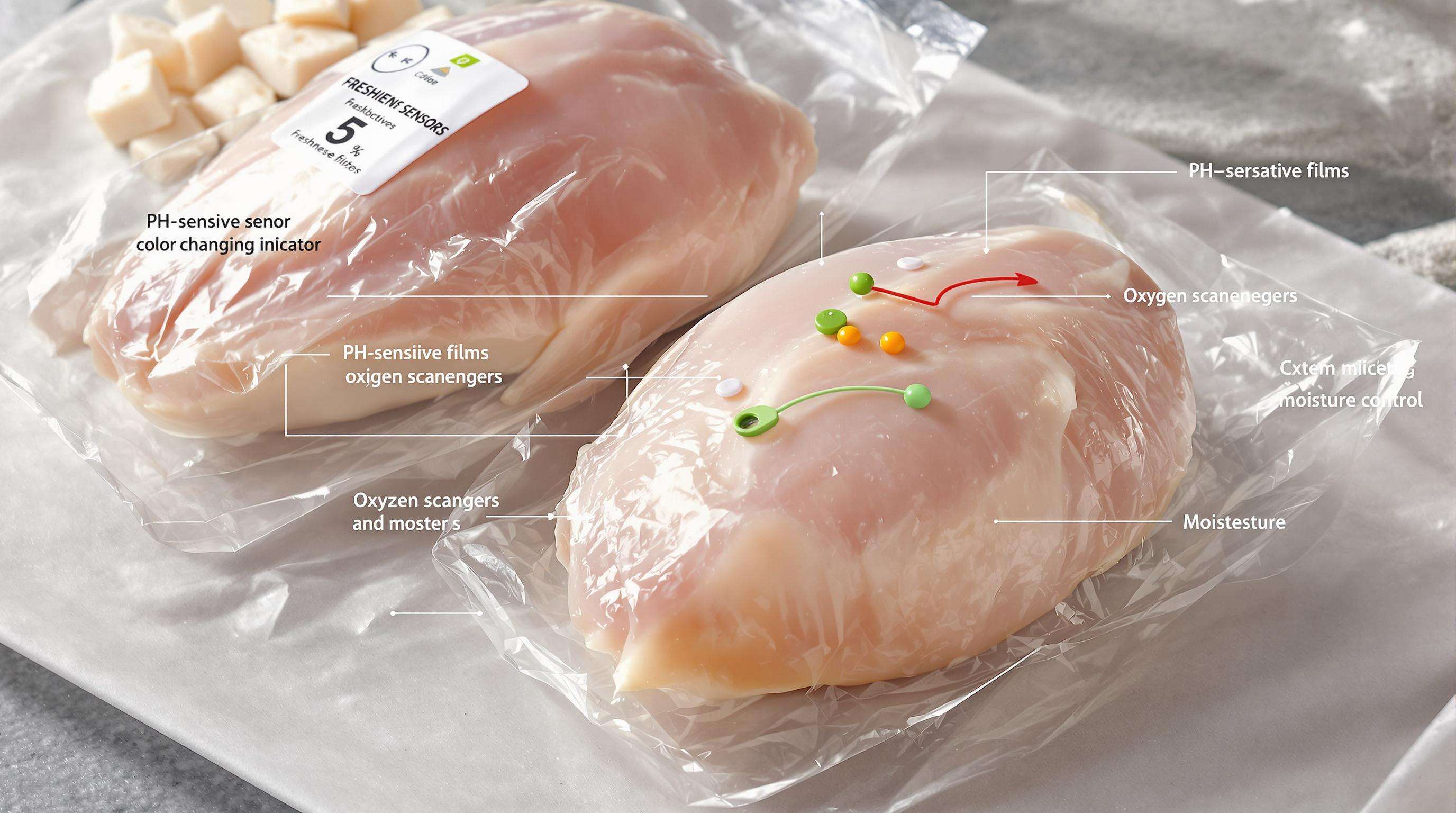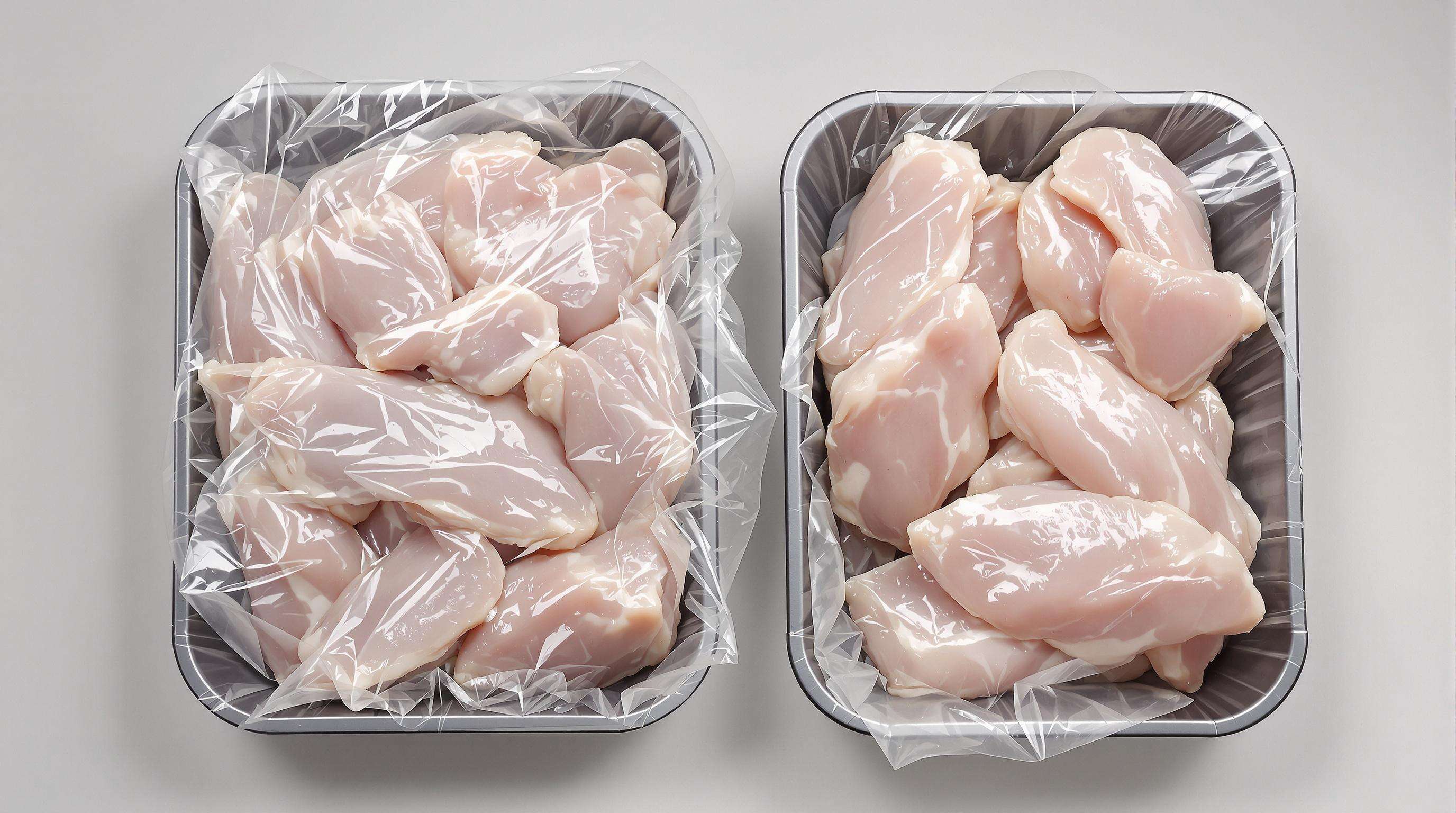কিভাবে স্মার্ট প্যাকেজিং অ্যাডভান্সড প্রযুক্তির মাধ্যমে চিকেনের শেল্ফ লাইফ বাড়ানো

চিকেনের জন্য বুদ্ধিমান খাদ্য প্যাকেজিং এবং সতেজতার ওপর এর প্রভাব বোঝা
স্মার্ট চিকেন প্যাকেজিং আজকাল অক্সিজেন ঢুকলে এবং ব্যাকটেরিয়া বাড়লে খাবার নষ্ট হওয়া রোখার জন্য সেন্সর এবং বিশেষ উপাদানগুলি একসাথে ব্যবহার করা হয়। নতুন সিস্টেমগুলি মাংসের সতেজতা পর্যবেক্ষণ করে এবং এটি সংরক্ষণেও সহায়তা করে। মুরগির সরবরাহ লাইনে খাবার নষ্ট হওয়া প্রায় 30 শতাংশ কমেছে বলে সাম্প্রতিক বাজার গবেষণায় দেখা গেছে। যখন প্যাকেজিংয়ের ভিতরে pH সংবেদনশীল ফিল্ম এবং গ্যাস সনাক্তকরণের সামগ্রী রাখা হয়, তখন রঙ পরিবর্তনকারী স্টিকার বা স্মার্টফোন অ্যাপ্লিকেশনের মাধ্যমে গুণগত মান সম্পর্কে লাইভ আপডেট পাঠানো যায়। এটি দোকানগুলি এবং ক্রেতাদের মুরগির পণ্যগুলির ব্যাপারে আরও পরিষ্কার ধারণা দেয়।
সক্রিয় প্যাকেজিংয়ের মাধ্যমে মুরগির মাংসের শেলফ জীবন বৃদ্ধির প্রধান প্রক্রিয়াসমূহ
তিনটি প্রধান প্রযুক্তি শেলফ জীবন বৃদ্ধির জন্য কাজ করে:
| প্রযুক্তি | কার্যকারিতা | কার্যকারিতা |
|---|---|---|
| অক্সিজেন ধ্বংসকারী | অবশিষ্ট O হ্রাস করে | 4-7 দিন সতেজতা বাড়ায় |
| অ্যান্টিমাইক্রোবিয়াল ফিল্ম | E. coli/সালমনেলা বৃদ্ধি প্রতিরোধ করে | 99.9% রোগজীবাণু হ্রাস |
| আর্দ্রতা-নিয়ন্ত্রণকারী স্তর | টেক্সচার ক্ষতি রোধ করতে 70-80% RH বজায় রাখুন | 30% ধীর ময়েশ্চার চলাচল |
খাদ্য প্রকৌশল পর্যালোচনা খাদ্য প্রকৌশল পর্যালোচনা এই সিস্টেমগুলি যে সমন্বিতভাবে কাজ করে সে বিষয়টি নিশ্চিত করে—অক্সিজেন স্ক্যাভেঞ্জারগুলি অ্যান্টিমাইক্রোবিয়াল কার্যকারিতা বাড়ায় কারণ এগুলি অ্যানারোবিক অবস্থা তৈরি করে যা খাদ্য নষ্টকারী জীবাণুগুলি দমন করে।
পরিবর্তিত বায়ুমণ্ডল প্যাকেজিং (ম্যাপ) কীভাবে পোল্ট্রি গুণমান রক্ষা করে এবং স্টোরেজ সময় 50% পর্যন্ত বাড়ায়
পরিবর্তিত বায়ুমণ্ডল প্যাকেজিং বা এমএপি সাধারণ বাতাসের স্থানে গ্যাসের একটি বিশেষ মিশ্রণ দিয়ে কাজ করে, সাধারণত প্রায় 30% কার্বন ডাই অক্সাইড এবং 70% নাইট্রোজেন। এটি খাদ্যকে খারাপ করার জন্য দায়ী এনজাইমগুলোকে ধীর করে দিয়ে মুরগির মাংসকে দীর্ঘ সময় সতেজ রাখতে সাহায্য করে। জার্নাল অফ ফুড প্রোটেকশন-এ 2023 সালে প্রকাশিত একটি গবেষণায় আরও কিছু আকর্ষক তথ্য পাওয়া গেছে। তারা আবিষ্কার করেছেন যে প্যাকেজে যখন 20% সিও2 এর বেশি থাকে, তখন এটি আসলে প্সেউডোমোনাস ব্যাকটেরিয়ার বৃদ্ধি বন্ধ করে দেয়। এই ক্ষুদ্র জীবাণুগুলোই প্রথমে মুরগির মাংসকে নষ্ট করে দেয়। এর ফলে মুরগি সাধারণের তুলনায় প্রায় 2.5 দিন বেশি সময় ধরে দোকানের তাকে ভালো থাকে। আর এটি লক্ষণীয় যে, যখন কোম্পানিগুলো এই প্যাকেজে স্মার্ট তাপমাত্রা সেন্সর যোগ করে, তখন পরিবহনের সময় শীতল রাখার সমস্যা প্রায় 12% কম হয়। এটি দোকানের তাকে পণ্যগুলো খাওয়ার জন্য নিরাপদ থাকার সময়কে বাস্তবিকভাবে পরিবর্তিত করে।
পোল্ট্রি নিরাপত্তা এবং মানের জন্য সক্রিয় এবং বুদ্ধিমান প্যাকেজিংয়ে নতুন প্রযুক্তি
হাঁসের দুর্গন্ধ রোধ করতে অ্যান্টিমাইক্রোবিয়াল এজেন্ট ব্যবহার করে অ্যান্টিব্যাকটেরিয়াল সক্রিয় প্যাকেজিং
আজকাল হাঁসের প্যাকেজিংয়ে প্রায়শই অ্যান্টিমাইক্রোবিয়াল উপাদান যেমন অর্গানিক অ্যাসিড, নিসিন এবং ক্ষতিকারক ব্যাকটেরিয়া মোকাবেলার জন্য ক্ষুদ্র রৌপ্য কণা অন্তর্ভুক্ত থাকে। গত বছর 'ফুড সেফটি টেকনোলজি' পত্রিকায় প্রকাশিত গবেষণা থেকে দেখা যায় যে এই উপাদানগুলি সাধারণ প্যাকেজিং উপকরণের তুলনায় ব্যাকটেরিয়ার বৃদ্ধি প্রায় 60 শতাংশ কমিয়ে দেয়। কিছু কোম্পানি আরও এগিয়ে গিয়ে থাইম অয়েল মিশ্রিত কিটোস্যান ফিল্ম তৈরি করেছে যা মাংসের মানের USDA মানগুলি অক্ষুণ্ণ রেখে হাঁসকে প্রায় আট দিন সতেজ রাখে। কারণ অনেক ক্রেতা রাসায়নিক ছাড়াই খাবার সংরক্ষণ করতে পছন্দ করেন, তাই এই প্রাকৃতিক বিকল্পগুলির প্রতি মানুষের প্রতিক্রিয়া ভালো। সম্প্রতি একটি জরিপে দেখা গেছে যে প্রায় দুই তৃতীয়াংশ ক্রেতা সিনথেটিক সংরক্ষক উপাদান সম্বলিত পণ্য থেকে সচেতনভাবে দূরে থাকেন।
অক্সিজেন স্ক্যাভেঞ্জিং ফিল্ম এবং পোল্ট্রি মাংসে লিপিড জারণ প্রতিরোধে এদের ভূমিকা
অক্সিজেন শোষক ফিল্মগুলি রেফ্রিজারেটেড মুরগির মধ্যে লিপিড জারণ এবং দুর্গন্ধ প্রতিরোধ করার জন্য 0.01% এর নিচে অবশিষ্ট অক্সিজেনের মাত্রা বজায় রাখে। লৌহ-ভিত্তিক শোষকযুক্ত পলিথিন ফিল্ম দুর্গন্ধ উন্নয়নকে 42% কমিয়ে দেয়, $2.3 বিলিয়ন বৈশ্বিক তাজা পোল্ট্রি বাজারকে সমর্থন করে কারণ এটি কম চর্বি যুক্ত এবং স্থিতিশীল মাংসের সংমিশ্রণকে সক্ষম করে।
খাদ্য নিরাপত্তা পর্যবেক্ষণের জন্য বুদ্ধিমান প্যাকেজিংয়ে তাপমাত্রা এবং আর্দ্রতা সেন্সর
ব্লুটুথ সক্রিয় সেন্সরগুলি এখন প্যাকেজিংয়ের মধ্যে সরাসরি একীভূত হয়ে যায়, সরবরাহ শৃঙ্খলের মাধ্যমে তাপমাত্রা ট্র্যাকিংয়ে ±0.5°C সঠিকতা এবং নিরবিচ্ছিন্ন আর্দ্রতা পর্যবেক্ষণ সরবরাহ করে। ক্ষেত্র পরীক্ষা থেকে দেখা গেছে যে এই পদ্ধতি ব্যবহার করে খুচরা বিক্রেতারা শীত শৃঙ্খলের ব্যর্থতা 73% কমাতে পারে এবং আগের তুলনায় 40% খাদ্য অপচয় কমাতে পারে।
দৃশ্যমান নষ্ট হয়ে যাওয়ার সূচক যা প্যাকেটযুক্ত মুরগির উপর ভোক্তাদের আস্থা বাড়িয়ে দেয়
সতেজতা লেবেলে পিএইচ-संवेदনशील রং ক্ষতিগ্রস্ত হওয়া সনাক্ত করে 92% নির্ভুলতার সাথে, যেখানে গ্যাস-সূচক ট্যাগ অ্যামোনিয়ার মতো উদ্বায়ী জৈব যৌগিকগুলির প্রতি সাড়া দেয়, গন্ধ শনাক্ত হওয়ার 24–36 ঘন্টা আগে দৃশ্যমান সতর্কতা প্রদান করে। 2023 সালের একটি ভোক্তা অধ্যয়নে দেখা গেছে যে প্যাকেজযুক্ত মুরগি কেনার সময় 78% ক্রেতা এই বৈশিষ্ট্যগুলিকে অপরিহার্য বলে মনে করেন।
ভ্যাকুয়াম স্কিন প্যাকেজিং এবং অ্যান্টিমাইক্রোবিয়াল উপকরণ: মুরগির জন্য উচ্চ-প্রদর্শন সমাধান

টেক্সচার, চেহারা এবং শেলফ লাইফ সংরক্ষণে ভ্যাকুয়াম স্কিন প্যাকেজিং (VSP) এর সুবিধা
ভ্যাকুয়াম স্কিন প্যাকেজিং (VSP) অক্সিজেনের 99% অপসারণ করে, একটি শক্তিশালী, দ্বিতীয়-স্কিন বাধা গঠন করে যা মুরগির মান সংরক্ষণ করে। 2023 সালের মিট সায়েন্স জার্নাল অনুসারে ঐতিহ্যবাহী ট্রেগুলোর তুলনায় এই পদ্ধতি ব্যাকটেরিয়া বৃদ্ধি 50% কমায় এবং প্রাথমিক মানের 1% এর মধ্যে পর্যন্ত 12 দিন পর্যন্ত আর্দ্রতা বজায় রাখে। প্রধান সুবিধাগুলি হলো:
- বিলম্বিত লিপিড জারণ (সতেজতা 4–7 দিন পর্যন্ত বৃদ্ধি করে)
- রঙ বজায় রাখা (মুরগির স্তনের 90% লালচে রং সংরক্ষিত)
- ন্যূনতম ড্রিপ ক্ষতি (সাপ্তাহিক আর্দ্রতা ক্ষতি <1.5%)
খুচরো বিক্রেতারা শ্রিঙ্কেজে 30% হ্রাস এবং ভোক্তারা VSP-প্যাকড চিকেনে 40% ভালো সতেজতা লক্ষ করেন (পোল্ট্রি টেক রিপোর্ট 2023)।
কেস স্টাডি: ভিএসপি ব্যবহার করে ইউরোপীয় পোল্ট্রি ব্র্যান্ডগুলি প্রদর্শনের জীবনকাল 30% পর্যন্ত বাড়ায়
2023 সালে 12টি ইউরোপীয় খুচরো বিক্রেতার মধ্যে একটি পরীক্ষা VSP-এর বাণিজ্যিক প্রভাব প্রদর্শন করে:
| মেট্রিক | পারম্পরিক প্যাকেজিং | ভিএসপি বাস্তবায়ন | উন্নতি |
|---|---|---|---|
| গড় স্থায়িত্বকাল | 5 দিনের মধ্যে | 8 দিন | +৬০% |
| প্রতি SKU বিক্রয় | $1,200/সপ্তাহ | $1,560/সপ্তাহ | +30% |
| গ্রাহক অভিযোগ | ১৮% | 6% | -67% |
ইইউ মাংস প্যাকেজিং প্রচেষ্টা থেকে প্রাপ্ত তথ্য দেখায় যে ব্র্যান্ডগুলি অপচয় হ্রাস এবং প্রিমিয়াম পণ্যের বিক্রয় বৃদ্ধির মাধ্যমে 8 মাসের মধ্যে আরওআই অর্জন করে।
নিসিন এবং রৌপ্য ন্যানোপার্টিকলসহ প্রাকৃতিক অ্যান্টিমাইক্রোবিয়াল এজেন্টস চিকেন প্যাকেজিং-এ
নিসিনযুক্ত জৈব সক্রিয় প্যাকেজিং ব্যবহার করে নিষেধ করে Listeria monocytogenes শীতাতপ নিয়ন্ত্রিত চিকেনে 3.5 লগ সিএফইউ/গ্রাম (ফুড কন্ট্রোল 2024)। রৌপ্য ন্যানোপার্টিকলস (<20 এনএম) সরবরাহ করে:
- 99.9% হ্রাস স্যালমোনেলা ২৪ ঘণ্টার মধ্যে
- 85% ধীর বায়োফিল্ম গঠন
- জৈব অ্যাসিডের তুলনায় 50% দীর্ঘস্থায়ী অ্যান্টিমাইক্রোবিয়াল ক্রিয়াকলাপ
2024 খাদ্য নিরাপত্তা প্রতিবেদন অনুযায়ী এই এজেন্টগুলি মার্কিন যুক্তরাষ্ট্রের 22% তাজা পোল্ট্রি পণ্যে ব্যবহৃত হয়, এবং বার্ষিক 15% হারে বৃদ্ধি পাচ্ছে কারণ গ্রাহকরা রাসায়নিক-মুক্ত সংরক্ষণের পক্ষে মত দিচ্ছেন।
অ্যান্টিমাইক্রোবিয়াল প্যাকেজিং গ্রহণে নিয়ন্ত্রক এবং গ্রাহক চ্যালেঞ্জসমূহ
খাদ্যজনিত রোগের 17% প্রতিরোধের সম্ভাবনা থাকা সত্ত্বেও (সিডিসি অনুমান), 65% গ্রাহক ন্যানোপার্টিকল মাইগ্রেশন নিয়ে উদ্বেগ প্রকাশ করেন (ফুড প্যাকেজিং ফোরাম 2023)। নিয়ন্ত্রক পথগুলি উল্লেখযোগ্যভাবে পৃথক:
- EU : নতুন খাদ্য নিয়ন্ত্রণের জন্য 3 বছরের অনুমোদন প্রক্রিয়ার প্রয়োজন হয়
- USDA : খাদ্য যোগাযোগ পদার্থের জন্য 120-দিনের মূল্যায়ন
- এএপিএসি : জাপান এবং চীনে রৌপ্য ধাতুর নিরাপত্তা সীমা 400% দ্বারা পৃথক হয়
প্যাকেজিং খরচে 35% বৃদ্ধি এবং শেলফ জীবন 28% দীর্ঘতর হওয়ার মধ্যে একটি বৈকল্পিক পছন্দের মুখে দাঁড়াতে হয়, যেখানে "সক্রিয় উপাদান" দিয়ে লেবেল করা পণ্য এড়িয়ে চলে এমন 42% ক্রেতাদের দিকেও নজর দিতে হয় (গ্লোবাল কনজিউমার ইনসাইটস 2023)।
স্থিতিশীলতা এবং বাজারের চাহিদা সম্পর্কিত ভোক্তা প্রবণতা, স্মার্ট চিকেন প্যাকেজিং
শেলফ জীবন বর্ধন এবং নিরাপত্তা বৈশিষ্ট্যসহ স্মার্ট প্যাকেজিংয়ের চাহিদা বৃদ্ধি
মানুষ আজকাল স্মার্ট প্যাকেজিংয়ের প্রতি বেশ আগ্রহী হয়ে উঠেছে কারণ তারা চায় যে তাদের খাবার দীর্ঘ সময় ধরে সতেজ এবং নিরাপদ থাকুক। 2025 সালের জাতীয় চিকেন কাউন্সিলের কিছু গবেষণা অনুসারে, প্রায় প্রতি চারজন ক্রেতার মধ্যে তিনজন এখন প্যাকেটে সতেজতা নির্দেশক এবং শেলফ লাইফ ট্র্যাকার সহ প্যাকেজগুলি দেখছেন। এটি আসলে 2020 সালের তুলনায় বেশ বৃদ্ধি, যখন মাত্র এক চতুর্থাংশ ক্রেতা এমন করতেন। বিশেষ করে নব্বম প্রজন্মের মানুষ এই ধরনের পণ্যে বেশ আকৃষ্ট হয়েছে। প্রায় প্রতি দশজন মিলেনিয়ালদের মধ্যে আটজন সেই ব্র্যান্ডগুলি বেছে নেয় যারা তাদের পণ্যগুলিতে কোয়াড কোড যুক্ত করে থাকে যাতে ক্রেতারা সরবরাহ শৃঙ্খলের প্রতিটি পণ্যের উৎপত্তি স্থান পরীক্ষা করতে পারেন। এবং আকর্ষণীয় বিষয় হলো, দোকানগুলি প্রায় 20% বেশি পুনরাবৃত্তি ক্রয় লক্ষ্য করে থাকে যখন তারা সাধারণ প্যাকেজিং উপকরণের পরিবর্তে সেই বিশেষ অক্সিজেন শোষক ফিল্মে মোড়ানো পণ্যগুলি স্টক করে।
পোল্ট্রি খুচরা বাণিজ্যে স্থিতিশীল এবং স্বচ্ছ প্যাকেজিংয়ের দিকে ঝোঁক
আজকাল নিয়মিত প্লাস্টিকের পরিবর্তে আরও পরিবেশবান্ধব কিছু দিয়ে প্রতিস্থাপনের দাবি বাড়ছে। 2025 সালের খাদ্য প্যাকেজিং প্রবণতা রিপোর্ট অনুসারে প্রায় দুই তৃতীয়াংশ ক্রেতা বায়োডিগ্রেডেবল উপকরণ বা পুনর্ব্যবহারযোগ্য সেলুলোজ ফিল্ম দিয়ে তৈরি মুরগির মাংসের প্যাকেজের জন্য অতিরিক্ত অর্থ ব্যয় করতে ইচ্ছুক। দেশ জুড়ে বৃহৎ বাক্স সংযুক্ত দোকানগুলি কেবলমাত্র স্ট্যান্ডার্ড কার্বসাইড বর্জ্য বাক্সের সাথে সামঞ্জস্যপূর্ণ একক উপকরণের VSP প্যাকেজিংয়ে স্যুইচ করে প্রায় এক তৃতীয়াংশ বর্জ্য কমিয়েছে। কিছু কোম্পানি চিংড়ির খোলস থেকে প্রাপ্ত (কিটোস্যান নামে পরিচিত) আবরণের সাথে পরীক্ষা-নিরীক্ষা করছে যা খাবারকে সতেজ রাখার পাশাপাশি প্রায় চল্লিশ শতাংশ পর্যন্ত রাসায়নিক সংরক্ষক কমায় এবং পণ্যগুলির ভান্ডার কালের উপর কোনও প্রভাব ফেলে না যা USDA মানদণ্ডের সাথে সামঞ্জস্যপূর্ণ। এবং গত বছরের ম্যাটেরিয়াল ইনোভেশন রিভিউতে উল্লিখিত ব্লকচেইন ট্র্যাকিং সিস্টেমগুলির কথা ভুলবেন না। এই ডিজিটাল সরঞ্জামগুলি স্থায়ীত্ব নিয়ে কোম্পানিগুলির প্রকৃত প্রচেষ্টা সম্পর্কে ক্রেতাদের সন্দেহ দূর করতে সাহায্য করছে এবং লোকেদের প্রায় নিরানব্বই শতাংশ সন্দেহ দূর করতে সক্ষম হচ্ছে।
প্রযুক্তিগত উদ্ভাবন এবং পরিবেশগত প্রভাব ও সংযোজনকারী উপাদান নিয়ে ক্রেতাদের উদ্বেগের মধ্যে ভারসাম্য বজায় রাখা
যেখানে 51% ক্রেতা স্মার্ট সেন্সরের স্বাগত জানান, সেখানে 47% ন্যানোপার্টিক্ল-ভিত্তিক অ্যান্টিমাইক্রোবিয়ালস নিয়ে সতর্ক থাকেন। 2026 কনজিউমার সেফটি সার্ভে দ্বন্দ্বপূর্ণ অগ্রাধিকারগুলি প্রকাশ করে:
- 89% ক্রেতা রাসায়নিক-মুক্ত সংরক্ষণের দাবি করেন
- 76% দীর্ঘতর শেলফ লাইফ অগ্রাধিকার দেয়
- 52% খাদ্য অপচয় কমাতে এদের ভূমিকা স্বীকার করেও প্যাকেজিং সংযোজনকারী উপাদানগুলির বিরোধিতা করেন
এই দ্বন্দ্ব গবেষণা ও উন্নয়নকে উদ্ভিদ-উৎপন্ন সমাধানগুলির দিকে ঠেলে দেয়, যেমন গুলঞ্চ নিষ্কাশন, যা সিন্থেটিক সংযোজনকারী উপাদান ছাড়াই 60% লিপিড জারণ হ্রাস করে। অক্সো-জৈব বিশ্লেষণযোগ্য উপকরণগুলি এখনও বিতর্কিত রয়েছে - 41% ক্রেতা ভুল ধারণা রাখেন যে তারা ল্যান্ডফিলগুলিতে পচে যায়। ভুল তথ্য প্রতিরোধের জন্য, নির্মাতারা এখন জীবন-চক্র মূল্যায়ন লেবেল ব্যবহার করছেন, যা সাধারণ পুনর্ব্যবহারযোগ্যতা প্রতীকগুলির তুলনায় 28% বেশি ক্রেতা আস্থা তৈরি করে।
সাধারণ জিজ্ঞাসা
স্মার্ট চিকেন প্যাকেজিংয়ে কোন প্রযুক্তিগুলি ব্যবহৃত হয়?
স্মার্ট চিকেন প্যাকেজিং অক্সিজেন স্ক্যাভেঞ্জার, অ্যান্টিমাইক্রোবিয়াল ফিল্ম এবং আর্দ্রতা-নিয়ন্ত্রণ স্তরের মতো প্রযুক্তি ব্যবহার করে শেলফ লাইফ বাড়াতে এবং তাজা রাখতে।
মডিফাইড অ্যাটমোস্ফিয়ার প্যাকেজিং (এমএপি) কীভাবে কাজ করে?
এমএপি কার্বন ডাই অক্সাইড এবং নাইট্রোজেনের মতো গ্যাসের মিশ্রণ দিয়ে সাধারণ বাতাস প্রতিস্থাপন করে দ্রুত নষ্ট হওয়া এনজাইমগুলিকে ধীর করে দেয়, যার ফলে শেলফ লাইফ বাড়ে।
স্মার্ট প্যাকেজিংয়ের বিষয়ে কি কোনও ভোক্তা উদ্বেগ রয়েছে?
হ্যাঁ, প্যাকেজিংয়ে যোগ করা যন্ত্রাংশগুলির ন্যানোপার্টিকেল মাইগ্রেশন এবং পরিবেশগত প্রভাবের বিষয়ে ভোক্তারা উদ্বিগ্নতা প্রকাশ করেন।
সূচিপত্র
- কিভাবে স্মার্ট প্যাকেজিং অ্যাডভান্সড প্রযুক্তির মাধ্যমে চিকেনের শেল্ফ লাইফ বাড়ানো
-
পোল্ট্রি নিরাপত্তা এবং মানের জন্য সক্রিয় এবং বুদ্ধিমান প্যাকেজিংয়ে নতুন প্রযুক্তি
- হাঁসের দুর্গন্ধ রোধ করতে অ্যান্টিমাইক্রোবিয়াল এজেন্ট ব্যবহার করে অ্যান্টিব্যাকটেরিয়াল সক্রিয় প্যাকেজিং
- অক্সিজেন স্ক্যাভেঞ্জিং ফিল্ম এবং পোল্ট্রি মাংসে লিপিড জারণ প্রতিরোধে এদের ভূমিকা
- খাদ্য নিরাপত্তা পর্যবেক্ষণের জন্য বুদ্ধিমান প্যাকেজিংয়ে তাপমাত্রা এবং আর্দ্রতা সেন্সর
- দৃশ্যমান নষ্ট হয়ে যাওয়ার সূচক যা প্যাকেটযুক্ত মুরগির উপর ভোক্তাদের আস্থা বাড়িয়ে দেয়
-
ভ্যাকুয়াম স্কিন প্যাকেজিং এবং অ্যান্টিমাইক্রোবিয়াল উপকরণ: মুরগির জন্য উচ্চ-প্রদর্শন সমাধান
- টেক্সচার, চেহারা এবং শেলফ লাইফ সংরক্ষণে ভ্যাকুয়াম স্কিন প্যাকেজিং (VSP) এর সুবিধা
- কেস স্টাডি: ভিএসপি ব্যবহার করে ইউরোপীয় পোল্ট্রি ব্র্যান্ডগুলি প্রদর্শনের জীবনকাল 30% পর্যন্ত বাড়ায়
- নিসিন এবং রৌপ্য ন্যানোপার্টিকলসহ প্রাকৃতিক অ্যান্টিমাইক্রোবিয়াল এজেন্টস চিকেন প্যাকেজিং-এ
- অ্যান্টিমাইক্রোবিয়াল প্যাকেজিং গ্রহণে নিয়ন্ত্রক এবং গ্রাহক চ্যালেঞ্জসমূহ
- স্থিতিশীলতা এবং বাজারের চাহিদা সম্পর্কিত ভোক্তা প্রবণতা, স্মার্ট চিকেন প্যাকেজিং
- সাধারণ জিজ্ঞাসা

